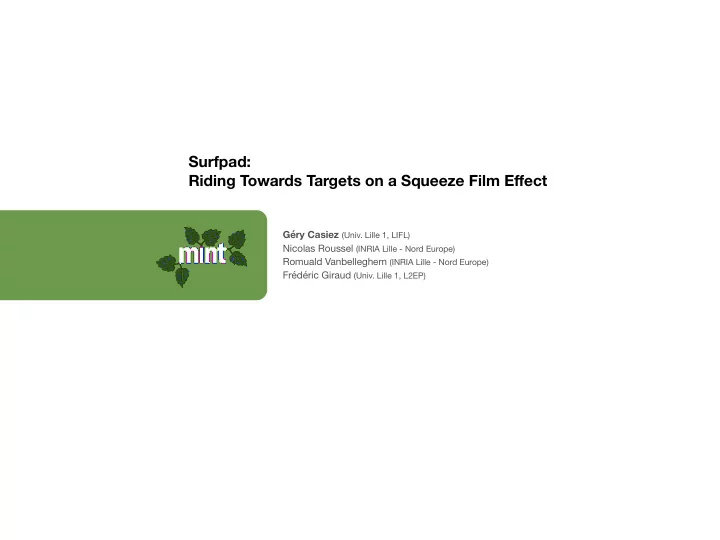

Surfpad: Riding Towards Targets on a Squeeze Film E ff ect a Géry Casiez (Univ. Lille 1, LIFL) a a Nicolas Roussel (INRIA Lille - Nord Europe) Romuald Vanbelleghem (INRIA Lille - Nord Europe) Frédéric Giraud (Univ. Lille 1, L2EP)
Pointing facilitation Most pointing facilitation techniques are target aware (e.g. Semantic Pointing, Sticky Targets) http://www.flickr.com/photos/jeanbaptisteparis/724619122/ What is a target? Only a few studies on the effect of distractors They conclude on their negative impact on movement time, error rate or user satisfaction
Pointing with haptic feedback Haptic = tactile + kinesthetic ‣ tactile : information received through nerve receptors in the skin ‣ kinesthetic : information sensed through movement and/or force to muscles and joints Many studies on the use of haptic for pointing, but ‣ based on active stimulation using simple electromagnetic technologies ‣ only a few take distractors into account Example of haptic technology using passive feedback : the squeeze film effect ‣ a simple principle : soften the contact with a surface by vibrating it using a very low amplitude but a high frequency ‣ more difficult to implement ... smooth smoother
STIMTAC (ALCOVE/MINT : Biet, Giraud & Semail) A surface with tactile feedback based on a squeeze film effect ‣ a matrix of piezoelectric ceramic cells coated on a copper-beryllium plate ‣ a vibration generated by the shrinking/stretching of the ceramics ‣ the variable amplitude of vibration allows to control the amount of friction Three years of work to build a 1D prototype and design a 2D plate Almost three more years to build this plate and optimize it
Surfpad
Surfpad A pointing technique using the STIMTAC A figure-ground reversal: as it is not possible to increase friction on targets, it is reduced everywhere else http://www.flickr.com/photos/remydugoua/4098087579/ A simple implementation using a step function Π ‣ 0 = maximum friction if over a target ‣ 127 = minimum friction otherwise Using a Bell-shape function Ω ‣ Smooth transition between minimum and maximum friction
First experiment 12 participants x 6 Techniques (Control, Control-, Semantic Pointing Π , Semantic Pointing Ω , Surfpad Π , Surfpad Ω ) distance (D) x 4 Blocks x 3 Distances (100, 50 & 25mm) x 3 Widths (16, 8 & 4 pixels) width (W) x 3 = 7,776 trials (c) cursor (a) target (b) Main results $"$# ‣ No difference between the two control conditions $"!# ("'# ‣ Surfpad Π improves movement time by 8.8% compared to ("&# !"#$%$&'()%$(*+,( the Control conditions ("%# ("$# ‣ No difference between Surfpad Ω and the two control ("!# -./01.,# -./01.,2# !"'# conditions 34+5.6/07# !"&# 34+5.6/08# ‣ Semantic pointing improves movement time by 17.7% !"%# 391:;<=7# !"$# compared to the Control conditions 391:;<=8# !"!# )*# )+# ),# ‣ interaction technique/width : no difference for large targets -./'0(
Discussion Mechanical effect (H1) or information feedback (H2) ? A detailed analysis of the movement time reveals that: ‣ There was no difference between the two control conditions ‣ Semantic Pointing Π , Semantic Pointing Ω , Surfpad Π significantly decreased the approaching time compared to the two control conditions (anticipation phenomenon) ‣ The integrals of Ω and Π are the same but there was no significant decrease in the stopping time for Ω This suggest a stronger effect of information feedback
Second experiment 9 participants x 3 Techniques (Control, Surfpad Π , Anti-Surfpad Π ) x 4 Blocks distance (D) x 3 Distances (100, 50 & 25mm) x 3 Widths (16, 8 & 4 pixels) x 3 = 2,916 trials width (W) (c) cursor (a) target (b) Main results $"%# $"$# ‣ Anti-Surfpad Π increased movement time for all target $"!# ("'# !"#$%$&'()%$(*+,( widths ("&# ("%# ‣ interaction technique/width : no difference for large targets ("$# ("!# but Surfpad Π improves movement time compared to -./01.,# !"'# !"&# 2/34561789:# Control and Anti-Surfpad Π for smaller target widths !"%# 561789:# !"$# !"!# )*# )+# ),# -./'0(
Discussion Negative mechanical effect stronger than the information feedback (H3) or counter- effective information feedback (H4) ? Require further experiments to conclude
Third experiment Targets separated by 100 mm (d) distractors 12 participants x 3 Techniques (Control, Semantic Pointing Ω & Surfpad Π ) distance (D) x 4 Blocks x 2 Widths (16 et 4 pixels) x 6 Density (0, 1, 2, 4, 8 & 12 distractors) width (W) x 3 = 5,184 trials (c) cursor (a) target (b) Main results 5.0 Control condi3on 4.5 Seman3c poin3ng Surfpad 4.0 ‣ Surfpad continues to improve movement time by 9,5% Movement )me (s) 3.5 compared to Control, whatever the number of distractors 3.0 2.5 ‣ Semantic Pointing degrades performance up to 100%, 2.0 due to clutching 1.5 1.0 0.5 0.0 0 1 2 4 8 12 Density
Discussion Why Surfpad is still efficient, even in the presence of distractors ? Reinforces our belief that Surfpad Π implementation mainly provides information feedback and little or no mechanical effect
Conclusion Surfpad is a target aware pointing facilitation technique ‣ as Semantic Pointing, it improves performance in the absence of distractor ‣ robust to distractors independently of their number Explanation : maybe a mechanical effect, but most likely information feedback Advantage : the question “What is a target ?” becomes less critical Feelings very similar to Tesla Touch
Contact : gery.casiez@lifl.fr, nicolas.roussel@inria.fr
Recommend
More recommend